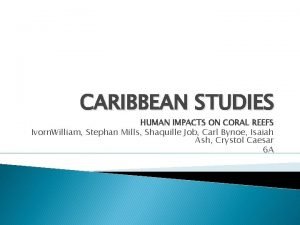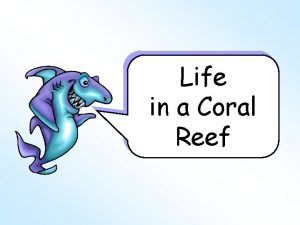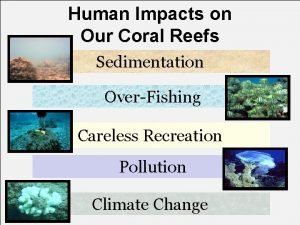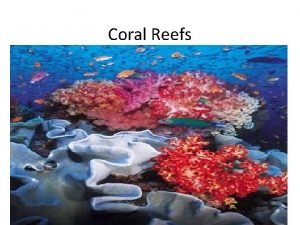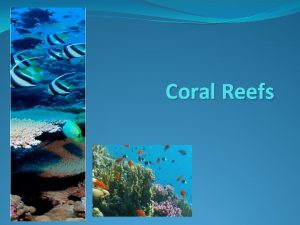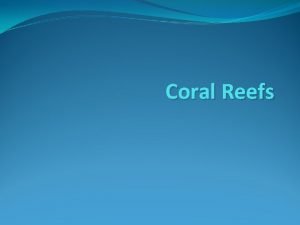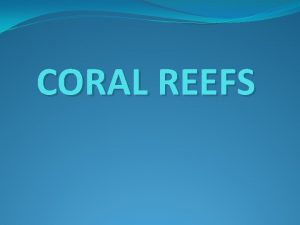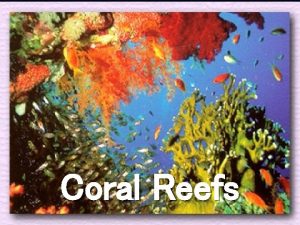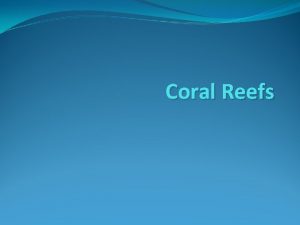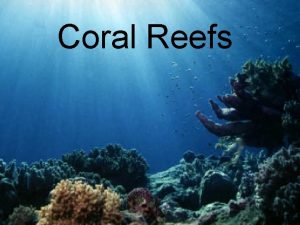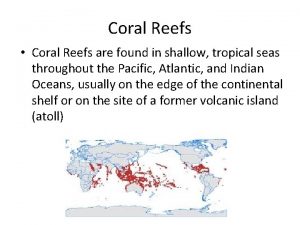Coral reefs Rainforests of the sea at risk









- Slides: 9

Coral reefs ‘Rainforests of the sea’ at risk Philip Allan Publishers © 2016

What is coral? • Corals are ancient marine organisms that evolved around 540 million years ago. • Despite being sensitive to light levels and temperature, corals have survived numerous mass extinction events in geological history. • Colourful, branching, tropical corals may look like plants are but are actually animals (marine invertebrates). • The coral animals, called polyps, are colonial and the familiar coral structures house them. • Coral polyps are filter feeders, using tentacles to trap plankton and even small fish. • Not all corals are tropical. Some species exist in cold waters but these tend to have only soft polyp bodies, not a hard skeleton. Philip Allan Publishers © 2016 This staghorn coral has a hard calcium carbonate skeleton, secreted by the colony of polyp animals that live within it

What are coral reefs? • Coral reefs consist of ‘stony’ corals with hard calcium carbonate skeletons. • Thousands of corals create a mound-like structure parallel to the shoreline. • The mound grows upward, on the ‘rubble’ of dead coral skeleton • Often there is a shallow, calm-water lagoon between the reef and beach. • Reefs are found in tropical seas which are: • Less than 50 m deep (polyps contain zooxanthellae algae that photosynthesise and produce some of the polyps’ food, so high light levels are needed) • Clear water, i. e. distant from river mouths which are a source of silt. • At temperatures of 23°– 29°C Philip Allan Publishers © 2016 Waves breaking on a reef in the Maldives, with a lagoon between reef and beach

Coral-reef ecosystem services • Coral reefs are said to be home to 25% of all marine species, but within an area of less than 1% of the world’s oceans. • This exceptional biodiversity is mirrored by very high productivity. • The Net Primary Productivity (NPP) of coral reefs is 2500 g / m 2 / year – higher even than tropical rainforests. • Reefs provide a wide range of crucial ecosystem services as shown in the table. Philip Allan Publishers © 2016 Regulating services Provisioning services • Carbon sequestration • Ocean water filtration • Fis /shellfish protein for humans • Fishing industry and jobs. • Building materials. • Medical and genetic research and products. Cultural services Supporting services • Tourism • Recreation and leisure • Aesthetic beauty • Coastal erosion prevention • A ‘nursery’ for small fish. maintaining fish populations. Worldwide, reefs provide about $30 billion in economic value each year. Hawaii’s reefs are worth $400 million to its economy annually.

Local and global threats • Coral reefs are subject to a wide range of threats. • These fall into two broad categories: 1. Local threats which result from over-exploitation of resources, affecting some reefs more than others. 2. Global threats as a result of climate change, affecting all reefs. Local • Overfishing. • Destructive fishing (trawling, dynamite and cyanide fishing) • Tourism/diving damage. • Siltation from onshore sediment flows, often linked to deforestation and farming erosion. • Eutrophication from urban, industrial and farm pollution. • Coral mining for building materials. Philip Allan Publishers © 2016 Global • Alien species invasion, linked to changing ocean temperatures. • Coral bleaching due to rising global sea temperatures and stronger El Niño events. • Ocean acidification, due to increased ocean carbon dioxide levels, weakening coral skeleton. • Rising sea levels ‘drowning ‘ coral in deeper water.

Coral reef health • Reefs form part of the wider marine ecosystem. • The WWF Living Planet Index (LPI) is a long-term measure of ecosystem health. • The Marine LPI (graph) has declined by 39% since 1970. • This suggests coral reefs, and other marine ecosystems such as seagrass beds and mangrove forests, are slowly being degraded by the wide range of threats facing them. • A 2011 Report by the World Resources Institute found that 75% of the world’s coral reefs were under threat. Philip Allan Publishers © 2016 © WWF International http: //wwf. panda. org/about_our_earth/all_publications/living_ planet_report/living_planet_index 2/

Changing distribution • The Reefs at Risk project has mapped reefs by level of threat worldwide. • This map of part of the Philippines shows that reefs fringing the large islands are mostly in the ‘high’ or ‘very high’ threat category. • Only more isolated, small island reefs are less threatened. • This pattern can be found worldwide, and it suggests coral reefs will disappear from most populated coastlines by 2030. • Rising populations and pressure of marine resources mean many coral reefs are on the verge of disappearing for ever. © 2012 World Resources Institute http: //www. wri. org/sites/default/files/pdf/reefs _at_risk_revisited_coral_triangle_hi-res. pdf Philip Allan Publishers © 2016

Management approaches • It’s not all bad news for coral reefs. • Over 6, 500 Marine Protected Areas help conserve around 2% of the world’s oceans, including many reefs. • There are examples of sustainable management. Reef-dependent communities are educated to conserve the reefs through ecotourism, sustainable fishing and management. • Coral-reef restoration is possible, although costly and challenging to implement. • The ever present ‘context threat’ of global warming makes conservation of reefs a difficult goal. © Commonwealth of Australia 2012 Large parts of Australia’s oceans are Marine Protected Areas and the Great Barrier Reef is a Marine Park. http: //www. marinereservescoalition. org/resources/marine-reservesaround-the-world/australias-marine-protected-area-network/ Philip Allan Publishers © 2016

This resource is part of GEOGRAPHY REVIEW, a magazine written for A-level students by subject experts. To subscribe to the full magazine go to: http: //www. hoddereducation. co. uk/geographyreview Philip Allan Publishers © 2016

